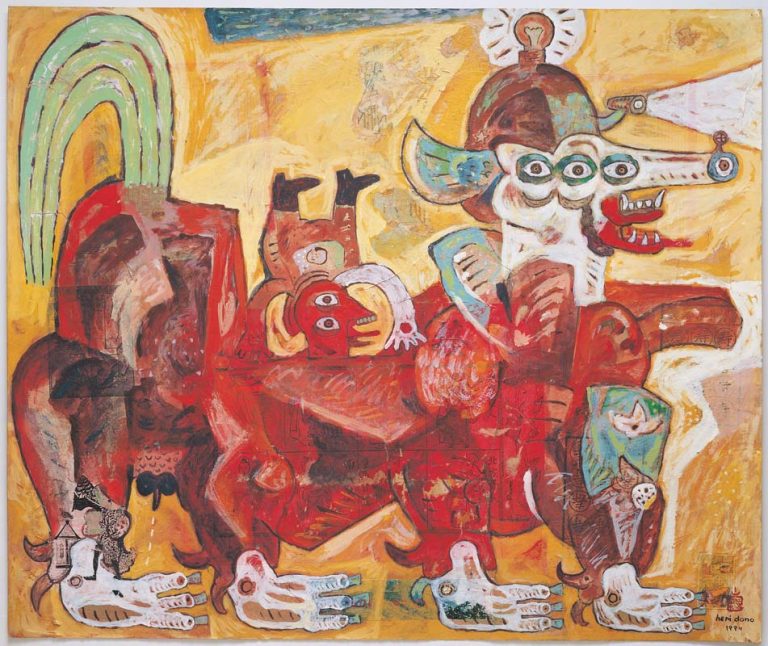We acknowledge the Traditional Owners of the land on which the Queensland Art Gallery | Gallery of Modern Art stands and recognise the creative contribution First Australians make to the art and culture of this country.

Heri Dono / Indonesia b.1960 / Bis kota (City bus) 1994 / Synthetic polymer paint and collage on cardboard / 66 x 77cm / Purchased 1995. Queensland Art Gallery Foundation / Collection: Queensland Art Gallery | Gallery of Modern Art / © Heri Dono
Heri DonoAda meriam di muka ku (There is a cannon on my face) 1994
On Display: Regional Touring Exhibition
Modern technology, global socio-political issues and Java’s classical art, dance and wayang puppetry, the traditional flat silhouette puppets of Java which are controlled by sticks attached to their jointed limbs, have all helped to form his art. He produces his own contemporary versions of wayang puppetry, one of which was performed at the first Asia-Pacific Triennial in 1993.
His work is closely tied to the traditions of Javanese culture, which incorporates mythological figures, often part human and part bird or beast, into epic narratives. Society and its foibles are sometimes parallelled or parodied in these stories, which are told by ‘wayang’ puppeteers in long, complex performances. Heri Dono uses his own bestiary of grotesque beings to comment on the comedy and tragedy of the human condition.
Heri Dono was born in Jakarta, Indonesia in 1960 and was raised in Semarang, Central Java. Between 1980 and 1987 he studied at the Indonesian Institute of the Arts in Yogyakarta, during which time there was an important debate focussing on Indonesian identity. Despite much opposition to the influences of Western art by his teachers, Dono concluded that seeking inspiration in the work of other artists was a natural part of the creative dialogue. At the time he gave close attention to the work of Pablo Picasso, Joan Miro and Vincent Van Gogh.
It is important to Heri Dono to use imagery from traditional Indonesian folk art as well as the classical fine arts (including the Buddhist and Hindu traditions of Indonesia), as a way of connecting his art directly with his own society. He is motivated by a love of his country’s culture, and the way it permeates through the society rather than producing alienation and elitism from the general population. He encourages the revival and regeneration of country and village art. The cultivated eccentricity and strangeness of his work is a gesture of resistance against the anonymous, corporate, world culture which threatens to reduce people everywhere to faceless mechanical components of a global network.